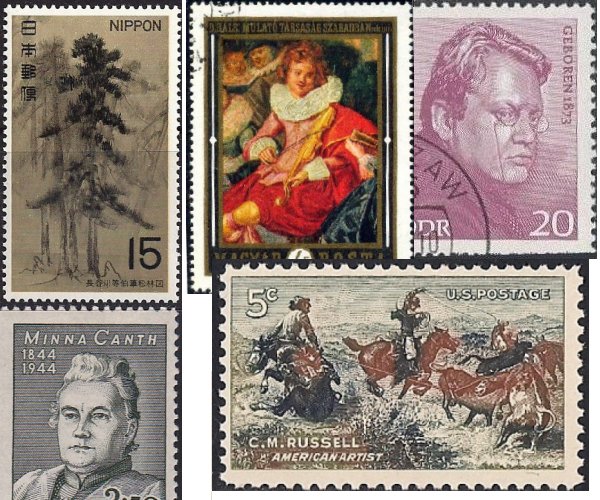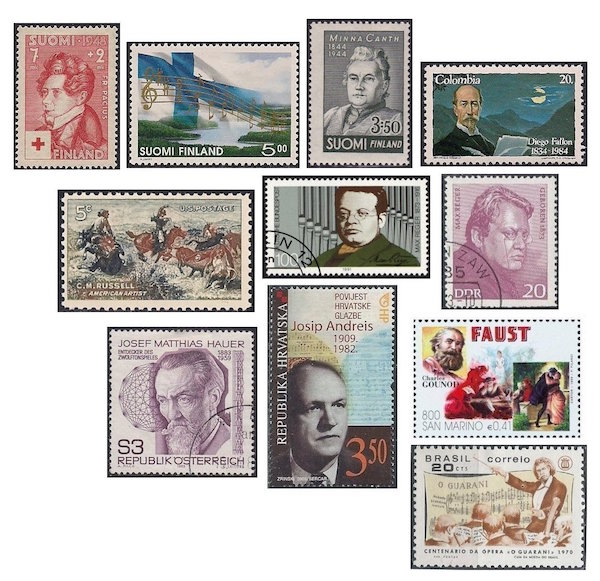The Arts on the Stamps of the World — March 19
An Arts Fuse regular feature: the arts on stamps of the world.

By Doug Briscoe
Three seventeenth-century painters from opposite ends of the world share a March 19 connection: it’s the birthday of Dirck Hals (1591 – 17 May 1656) and Alonzo Cano (1601 – 3 September 1667), and Hasegawa Tōhaku died on this day in 1610. Hasegawa Tōhaku (born 1539) founded the school of Japanese painting that is named for him. This school, a rather small Chinese-inspired one, seems to have concentrated its attention on the painting of sliding doors (fusuma). There were about a half dozen painters bearing the name Hasegawa into the early eighteenth century. The stamp depicts a single panel from a pair of six-folded screens called simply Pine Trees.
Our two other seventeenth-century painters were European. Dirck Hals was the younger brother of the more celebrated Frans Hals. Frans had been born at Antwerp, but the family fled the Spanish Occupation for Haarlem, where Dirck first saw the light of day and where, except for brief spells in Leiden, he spent the rest of his life. His work consists of small pictures of convivial contemporary life, as seen on this Hungarian stamp of 1969 showing a detail from Amusing Party in the Open Air (1621), which hangs in the Budapest Museum of Fine Arts.
His contemporary Alonzo (or Alonso) Cano, Dirck Hals’s junior by exactly ten years to the day, was an architect and sculptor besides being a painter. Born in Granada, he had different teachers for each of the three disciplines, learning architecture from his father and painting from Velázquez’s teacher Francisco Pacheco. The Spanish set of ten stamps, which, coincidentally, like the Hals stamp, also dates from 1969, is entirely devoted to the paintings. A list of titles can be supplied to the curious upon request. Cano led, shall we say, a colorful life. It appears his temper was so explosive that when his wife was murdered in a home robbery, he was accused of the crime, even though the servant had gone missing, and was exonerated only when he wouldn’t confess under torture. On the high side of Fortune’s wheel, Cano was architect and painter to Philip IV and tutor of the short-lived heir, Balthasar Charles. As an architect Cano’s most important work was his collaboration with Gaspar de la Peña for the façade of Granada Cathedral.
Fredrik Pacius (March 19, 1809 – January 8, 1891) was German, but spent most of his life in Finland, which is why the stamps are Finnish. He was responsible for the first Finnish opera, King Charles’s Hunt (1852; though the libretto is in Swedish), and in 1848 composed the song used today as the national anthem of both Finland (as “Maamme/Our Land”) and Estonia (“Mu isamaa, mu õnn ja rõõm/My Fatherland, My Happiness and Joy”). Pacius also wrote a symphony (1850), a violin concerto (1845), and a string quartet (1826), besides other works for the stage and vocal music. The first Pacius stamp was issued in 1948, the second, which specifically cites the anthem, in 1998.

We keep to Finland for our next subject, the writer Minna Canth (née Johnsson, 19 March 1844 – 12 May 1897), who was a strong voice for women’s rights, particularly decrying the prevalent denial of free expression and of the fulfillment of achievement among women. Naturally her views were not shared by the conservative element of society, yet her play The Worker’s Wife (1885) did result in legislation, just months after its premiere, to address the injustice of exclusive male property ownership in marriage. Her most famous play, though, is The Pastor’s Family (1891), a story of the rebellion of the children against the father’s hidebound conservatism. Canth also wrote nonfiction books on social issues. March 19 is a national holiday in Finland, the Day of Equality, when the Finnish flag, as seen on the aforementioned Pacius stamp, is customarily flown.
The Colombian poet Diego Fallon (March 19, 1834 – August 24, 1905) was born to an Irish father and Colombian mother in the town of Santa Ana, which in 1930 was named Falán in his honor. Educated in England, he learned piano, violin, and guitar and hoped to become a musician. In the end, although his father insisted he study railway engineering, Fallon devoted his life to academe. A remarkable polymath, he taught languages (he was fluent in Spanish, Latin, English, Italian, and French), mathematics, and aesthetics, as well as becoming the first teacher of piano at the National Music Academy in Bogotá. He also composed some songs and made chamber arrangements of music from Italian opera.
Charles Marion Russell (March 19, 1864 – October 24, 1926), sometimes referred to as “Kid” Russell or “the cowboy artist”, made more than 2,000 paintings of the Old American West. He was born and grew up in Missouri and always had him a hankerin’ fer drawin’ ‘n’ sketchin’ when he was a young’un. At sixteen he went to Montana to work on a ranch and chose to live in the state. Once when a ranch owner asked for a report on how the cattle had thrived over the winter, the foreman chose to reply by sending a tiny painting Russell had made of a thin cow being stalked by wolves. The owner was impressed, word got around, and Russell’s career was launched. He lived for a time among the Blackfeet Indians and thrived in an age when the fascination with the West was producing such phenomena as Buffalo Bill’s Wild West. The centennial (1964) stamp shows Russell’s 1907 painting Jerked Down. He also worked in bronze sculptures and other media and wrote a book of short stories that was posthumously published.
Of Max Reger (19 March 1873 – 11 May 1916), a reviewer in Gramophone magazine once wrote: “When a Munich critic around the turn of the century declared that Reger’s [works] ‘address themselves to future audiences,’ he was uttering what seems to be an eternal truth. Unfortunately for Reger, his audiences are still in the future and give every sign that they intend to stay there.” And yet Reger’s music has certainly been extensively represented in recordings. He was a great admirer of Bach and tended to write learned, rather thickly textured scores, but many of his piano miniatures are more transparent, and some I find quite delightful.

The Austrian composer Josef Matthias Hauer (March 19, 1883 – September 22, 1959) developed a twelve-tone method a year or two before Arnold Schoenberg’s, publishing his “law of the twelve tones” in August of 1919. (The system differs in some particulars from Schoenberg’s.) In youth he studied cello, choral conducting, and organ. A prolific composer, he left nearly 600 scores, including a cantata, “Wandlungen,” and a violin concerto, both premièred by Scherchen, and an opera, Salambo, that was given its first performance under Klemperer. Condemned as “degenerate” by the Nazis, he remained in Austria throughout the war but published no more music until after the Allied victory. He also wrote extensively on theory.
Another prolific writer on music was the Croatian musicologist Josip Andreis (19 March 1909 – 16 January 1982). His most important work is probably his History of Croatian Music. He was a professor of music, president of the Croatian Composers’ Association, and founder of the Musicology Institute, which he directed from 1969 to 1972.
Today is the 158th anniversary of Charles Gounod’s opera Faust, first heard at the Théâtre Lyrique in Paris on 19 March 1859, and the 147th anniversary of the première of Carlos Gomes’s Guaraní, given at La Scala on 19 March 1870. While the San Marino stamp is merely one from a sheet of composers and their operas, the Brazilian stamp specifically addresses the centenary of Guaraní’s first performance.
A graduate of the University of Massachusetts with a B.A. in English, Doug Briscoe worked in Boston classical music radio, at WCRB, WGBH, and WBUR, for about 25 years, beginning in 1977. He has the curious distinction of having succeeded Robert J. Lurtsema twice, first as host of WGBH’s weekday morning classical music program in 1993, then as host of the weekend program when Robert J.’s health failed in 2000. Doug also wrote liner notes for several of the late Gunther Schuller’s GM Recordings releases as well as program notes for the Boston Classical Orchestra. For the past few years he’s been posting a Facebook “blog” of classical music on stamps of the world, which has now been expanded to encompass all the arts for The Arts Fuse.
